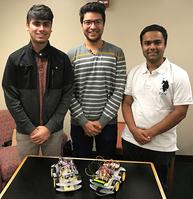Winning IoT Designs Announced in Electronic Design Contest
Purdue Engineering students were challenged to develop a design that would connect the world through the Internet of Things (IoT) using Digi-Key’s Scheme-It tool, Texas Instruments’ TM4C123G LaunchPad as the building block, and incorporating at least one TE Connectivity component into the design.
First place went to Biomedical Engineering PhD student Orlando Hoilett, who designed a Multi-Sensor Fitness Band. The band is a wearable biometrics sensor that can monitor important biomarkers for health and fitness including dehydration, heart rate, blood oxygenation, skin temperature and humidity. When biosensor data is combined with weather and geographical data, the goal is to ultimately create a susceptibility score/risk factor for illness.
Second place went to a team made up of Electrical and Computer Engineering students Ribhav Agarwal, Alek Patel and Vinay Nagarajan. They created a car designed to provide connectivity for the user to operate the vehicle via sensors.
Third place went to Electrical and Computer Engineering PhD student Supriyo Maji, who created a design that uses force sensors fitted in food containers to monitor daily intake of nutrition by measuring and calculating the change in weight of the food.
The design competition was the second phase of the 2016 Engineering Academic Program Bracket Challenge. The initial bracket paired 32 electrical, mechanical, and computer engineering academic programs, and the magazines’ audiences and engineering students voted weekly for five weeks to select the bracket winner. Purdue University was the winning academic program, and its Engineering students were eligible to participate in an online juried designed challenge. This the third annual bracket contest held by Electronic Design and Machine Design.
The 2017 contest kicked off on March 1, 2017, with 32 engineering universities on the bracket.



